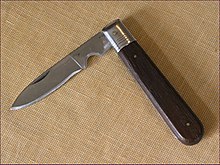Penknife



Penknife, or pen knife, is a small folding knife.[1] Today penknife is also the common British English term for both a pocketknife, which can have single or multiple blades, and for multi-tools, with additional tools incorporated into the design.[2]
History
Originally, penknives were used for thinning and pointing quills (cf. penna, Latin for feather) to prepare them for use as dip pens and, later, for repairing or re-pointing the nib.[1] A penknife might also be used to sharpen a pencil,[3] prior to the invention of the pencil sharpener. In the mid-1800s, penknives were necessary to slice the uncut edges of newspapers and books.[4]
A penknife did not necessarily have a folding blade, but might resemble a scalpel or chisel by having a short, fixed blade at the end of a long handle.[citation needed]
During the 20th century there has been a proliferation of multi-function pocketknives with assorted blades and gadgets,[5] the most famous of which is the Swiss Army knife, referred to in British English as penknives.
A larger folding knife than a penknife, especially one in which the blade locks into place as a protection, as for skinning animals, is referred to by some as a claspknife.[5]
Text is available under the CC BY-SA 4.0 license; additional terms may apply.
Images, videos and audio are available under their respective licenses.
